Page 273 of 424
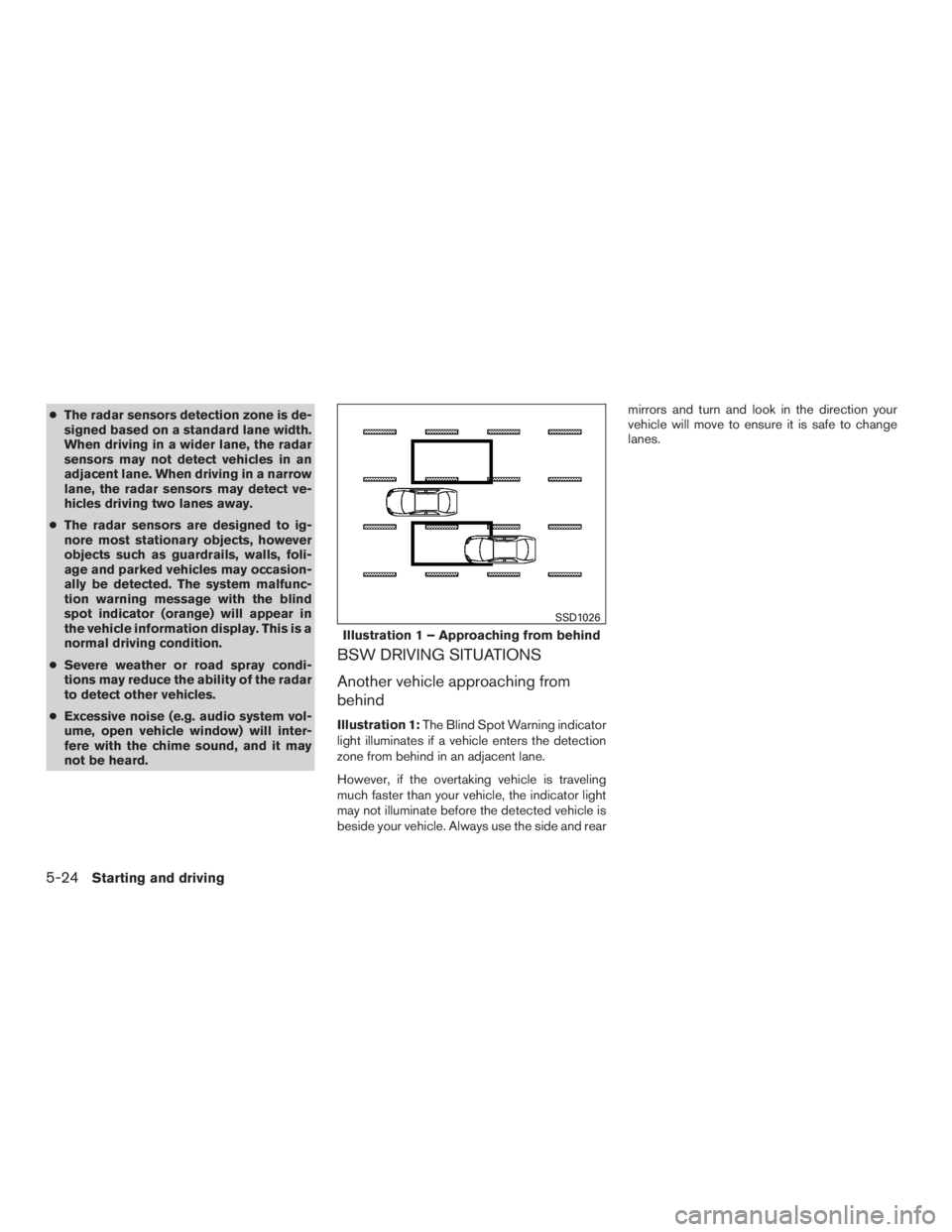
●The radar sensors detection zone is de-
signed based on a standard lane width.
When driving in a wider lane, the radar
sensors may not detect vehicles in an
adjacent lane. When driving in a narrow
lane, the radar sensors may detect ve-
hicles driving two lanes away.
● The radar sensors are designed to ig-
nore most stationary objects, however
objects such as guardrails, walls, foli-
age and parked vehicles may occasion-
ally be detected. The system malfunc-
tion warning message with the blind
spot indicator (orange) will appear in
the vehicle information display. This is a
normal driving condition.
● Severe weather or road spray condi-
tions may reduce the ability of the radar
to detect other vehicles.
● Excessive noise (e.g. audio system vol-
ume, open vehicle window) will inter-
fere with the chime sound, and it may
not be heard.
BSW DRIVING SITUATIONS
Another vehicle approaching from
behind
Illustration 1: The Blind Spot Warning indicator
light illuminates if a vehicle enters the detection
zone from behind in an adjacent lane.
However, if the overtaking vehicle is traveling
much faster than your vehicle, the indicator light
may not illuminate before the detected vehicle is
beside your vehicle. Always use the side and rear mirrors and turn and look in the direction your
vehicle will move to ensure it is safe to change
lanes.
Page 276 of 424
Entering from the side
Illustration 7:The Blind Spot Warning indicator
light illuminates if a vehicle enters the detection
zone from either side.
NOTE:
The radar sensors may not detect a vehicle
which is traveling at about the same speed
as your vehicle when it enters the detection
zone. Illustration 8:
Illustration 8: If the driver acti-
vates the turn signal while another vehicle is in the
detection zone the Blind Spot Warning indicator
light flashes and a chime will sound twice.
NOTE:
If the driver activates the turn signal before
a vehicle enters the detection zone, the
Blind Spot Warning indicator light will flash
but no chime will sound when another ve-
hicle is detected.
Page 279 of 424
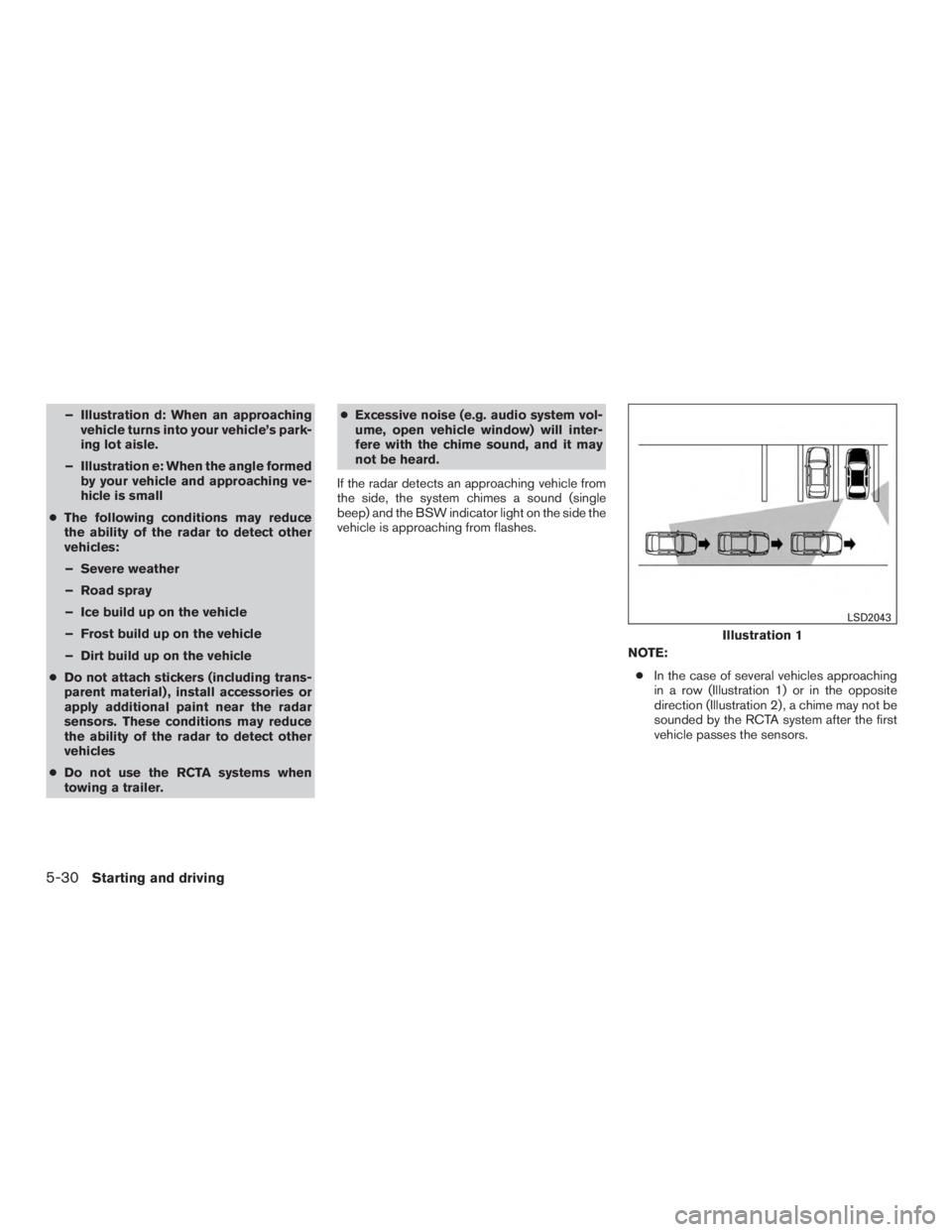
– Illustration d: When an approachingvehicle turns into your vehicle’s park-
ing lot aisle.
– Illustration e: When the angle formed by your vehicle and approaching ve-
hicle is small
● The following conditions may reduce
the ability of the radar to detect other
vehicles:
– Severe weather
– Road spray
– Ice build up on the vehicle
– Frost build up on the vehicle
– Dirt build up on the vehicle
● Do not attach stickers (including trans-
parent material) , install accessories or
apply additional paint near the radar
sensors. These conditions may reduce
the ability of the radar to detect other
vehicles
● Do not use the RCTA systems when
towing a trailer. ●
Excessive noise (e.g. audio system vol-
ume, open vehicle window) will inter-
fere with the chime sound, and it may
not be heard.
If the radar detects an approaching vehicle from
the side, the system chimes a sound (single
beep) and the BSW indicator light on the side the
vehicle is approaching from flashes.
NOTE:● In the case of several vehicles approaching
in a row (Illustration 1) or in the opposite
direction (Illustration 2) , a chime may not be
sounded by the RCTA system after the first
vehicle passes the sensors.
Page 284 of 424
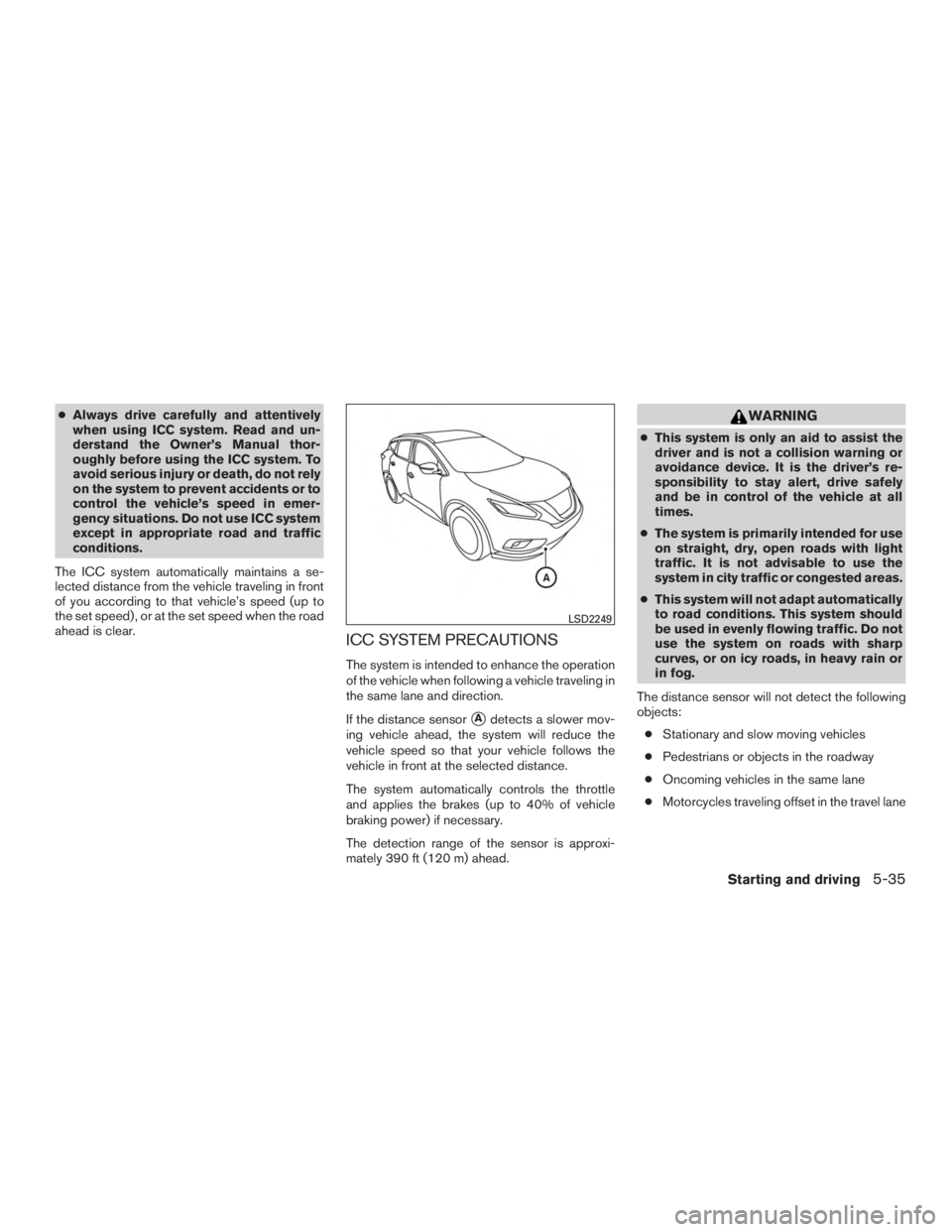
●Always drive carefully and attentively
when using ICC system. Read and un-
derstand the Owner’s Manual thor-
oughly before using the ICC system. To
avoid serious injury or death, do not rely
on the system to prevent accidents or to
control the vehicle’s speed in emer-
gency situations. Do not use ICC system
except in appropriate road and traffic
conditions.
The ICC system automatically maintains a se-
lected distance from the vehicle traveling in front
of you according to that vehicle’s speed (up to
the set speed) , or at the set speed when the road
ahead is clear.
ICC SYSTEM PRECAUTIONS
The system is intended to enhance the operation
of the vehicle when following a vehicle traveling in
the same lane and direction.
If the distance sensor
�Adetects a slower mov-
ing vehicle ahead, the system will reduce the
vehicle speed so that your vehicle follows the
vehicle in front at the selected distance.
The system automatically controls the throttle
and applies the brakes (up to 40% of vehicle
braking power) if necessary.
The detection range of the sensor is approxi-
mately 390 ft (120 m) ahead.
Page 285 of 424
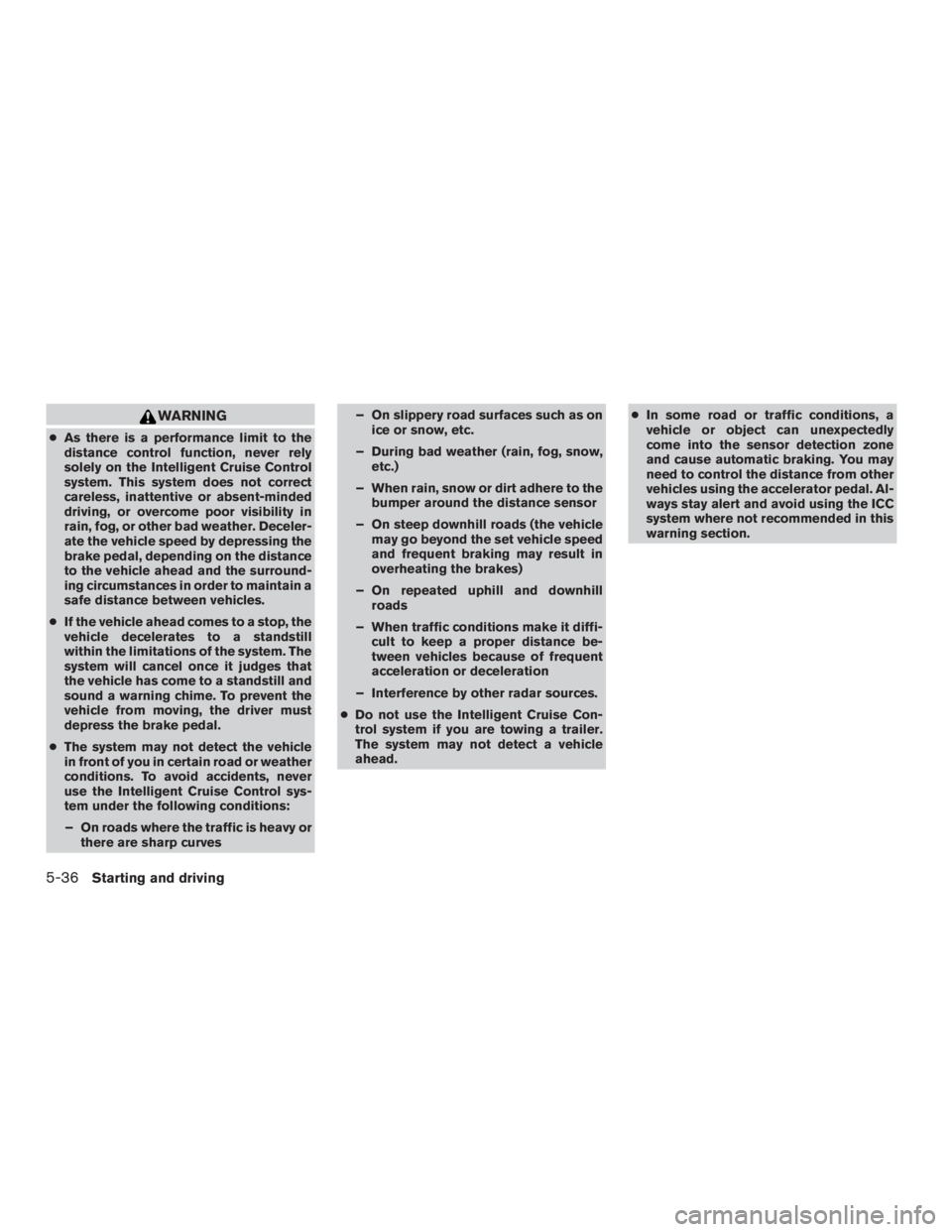
WARNING
●As there is a performance limit to the
distance control function, never rely
solely on the Intelligent Cruise Control
system. This system does not correct
careless, inattentive or absent-minded
driving, or overcome poor visibility in
rain, fog, or other bad weather. Deceler-
ate the vehicle speed by depressing the
brake pedal, depending on the distance
to the vehicle ahead and the surround-
ing circumstances in order to maintain a
safe distance between vehicles.
● If the vehicle ahead comes to a stop, the
vehicle decelerates to a standstill
within the limitations of the system. The
system will cancel once it judges that
the vehicle has come to a standstill and
sound a warning chime. To prevent the
vehicle from moving, the driver must
depress the brake pedal.
● The system may not detect the vehicle
in front of you in certain road or weather
conditions. To avoid accidents, never
use the Intelligent Cruise Control sys-
tem under the following conditions:
– On roads where the traffic is heavy or there are sharp curves – On slippery road surfaces such as on
ice or snow, etc.
– During bad weather (rain, fog, snow, etc.)
– When rain, snow or dirt adhere to the bumper around the distance sensor
– On steep downhill roads (the vehicle may go beyond the set vehicle speed
and frequent braking may result in
overheating the brakes)
– On repeated uphill and downhill roads
– When traffic conditions make it diffi- cult to keep a proper distance be-
tween vehicles because of frequent
acceleration or deceleration
– Interference by other radar sources.
● Do not use the Intelligent Cruise Con-
trol system if you are towing a trailer.
The system may not detect a vehicle
ahead. ●
In some road or traffic conditions, a
vehicle or object can unexpectedly
come into the sensor detection zone
and cause automatic braking. You may
need to control the distance from other
vehicles using the accelerator pedal. Al-
ways stay alert and avoid using the ICC
system where not recommended in this
warning section.
5-36Starting and driving
Page 300 of 424
WARNING
●The Predictive Forward Collision Warn-
ing system does not function when a
vehicle ahead is a narrow vehicle, such
as a motorcycle. The radar sensor may
not detect a second vehicle ahead in the
following conditions:
– Snow or heavy rain.
– Dirt, ice, snow or other material cov- ering the radar sensor.
– Interference by other radar sources. – Snow or road spray from travelling
vehicles.
– Driving in a tunnel.
Page 302 of 424
WARNING
●The radar sensor may not detect a sec-
ond vehicle when the vehicle ahead is
being towed.
● When the distance to the vehicle ahead
is too close, the beam of the radar sen-
sor is obstructed.
● The radar sensor may not detect a sec-
ond vehicle when driving on a steep
downhill slope or on roads with sharp
curves. ●
Excessive noise will interfere with the
warning tone sound, and it may not be
heard.System temporarily unavailable
Condition A:
When the radar sensor picks up interference
from another radar source, making it impossible
to detect a vehicle ahead, the Predictive Forward
Collision Warning system is automatically turned
off.
The Forward Emergency Braking system warning
light (orange) and the driver assist system for-
ward indicator (orange) will illuminate.
Page 319 of 424
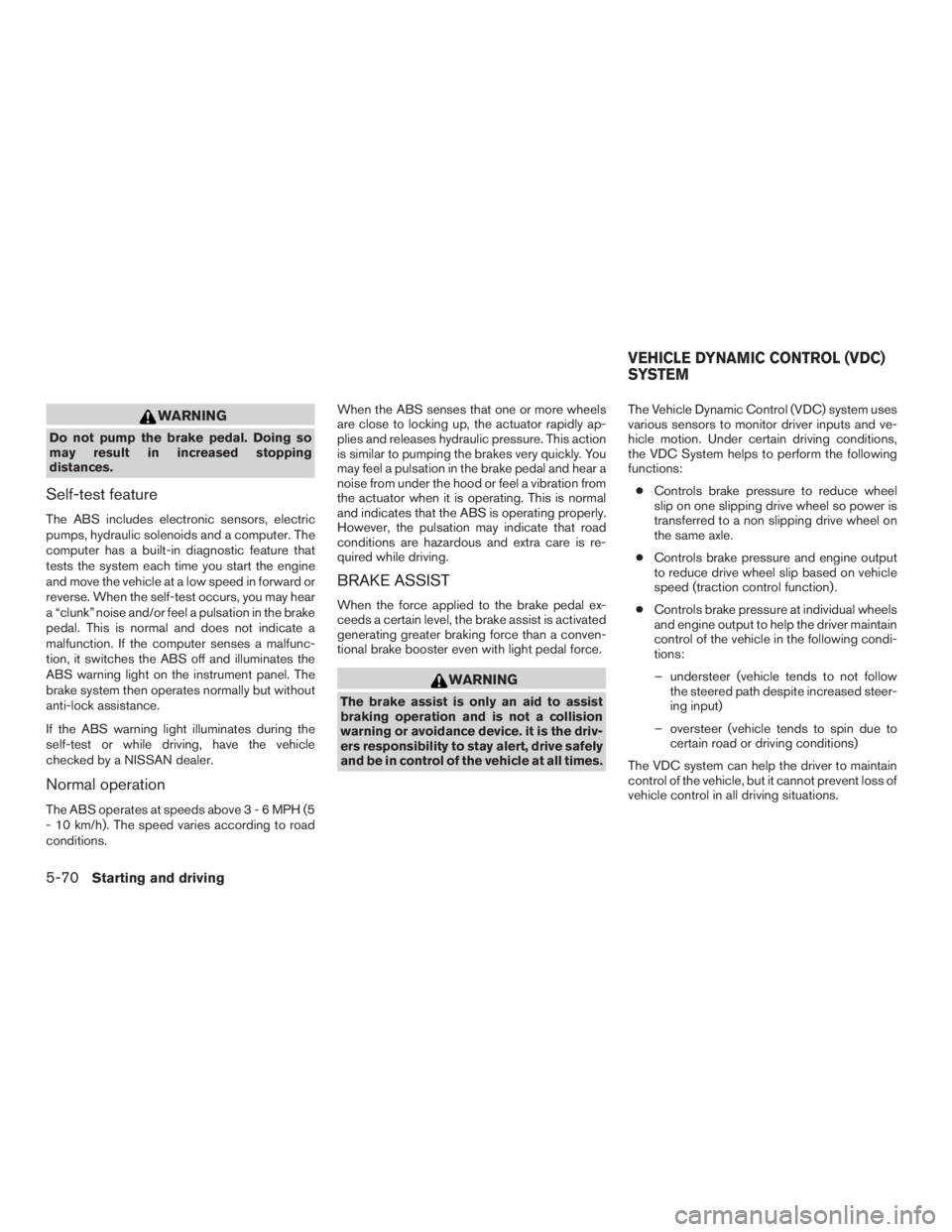
WARNING
Do not pump the brake pedal. Doing so
may result in increased stopping
distances.
Self-test feature
The ABS includes electronic sensors, electric
pumps, hydraulic solenoids and a computer. The
computer has a built-in diagnostic feature that
tests the system each time you start the engine
and move the vehicle at a low speed in forward or
reverse. When the self-test occurs, you may hear
a “clunk” noise and/or feel a pulsation in the brake
pedal. This is normal and does not indicate a
malfunction. If the computer senses a malfunc-
tion, it switches the ABS off and illuminates the
ABS warning light on the instrument panel. The
brake system then operates normally but without
anti-lock assistance.
If the ABS warning light illuminates during the
self-test or while driving, have the vehicle
checked by a NISSAN dealer.
Normal operation
The ABS operates at speeds above3-6MPH(5
- 10 km/h). The speed varies according to road
conditions.When the ABS senses that one or more wheels
are close to locking up, the actuator rapidly ap-
plies and releases hydraulic pressure. This action
is similar to pumping the brakes very quickly. You
may feel a pulsation in the brake pedal and hear a
noise from under the hood or feel a vibration from
the actuator when it is operating. This is normal
and indicates that the ABS is operating properly.
However, the pulsation may indicate that road
conditions are hazardous and extra care is re-
quired while driving.
BRAKE ASSIST
When the force applied to the brake pedal ex-
ceeds a certain level, the brake assist is activated
generating greater braking force than a conven-
tional brake booster even with light pedal force.